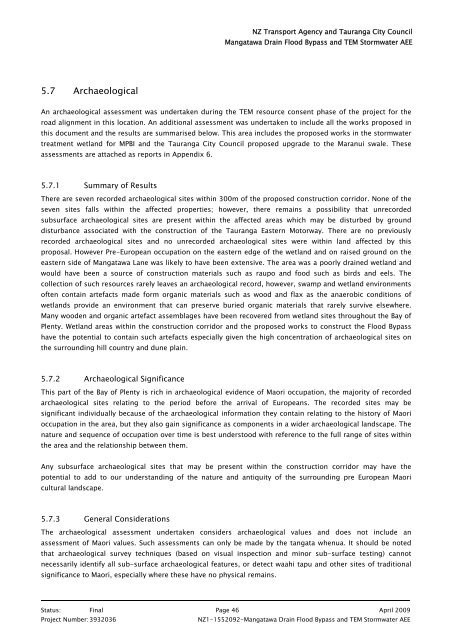2. Mangatawa catchment consents for earthworks, storm water ...
2. Mangatawa catchment consents for earthworks, storm water ...
2. Mangatawa catchment consents for earthworks, storm water ...
- No tags were found...
Create successful ePaper yourself
Turn your PDF publications into a flip-book with our unique Google optimized e-Paper software.
NZ Transport Agency and Tauranga City Council<br />
<strong>Mangatawa</strong> Drain Flood Bypass and TEM Storm<strong>water</strong> AEE<br />
5.7 Archaeological<br />
An archaeological assessment was undertaken during the TEM resource consent phase of the project <strong>for</strong> the<br />
road alignment in this location. An additional assessment was undertaken to include all the works proposed in<br />
this document and the results are summarised below. This area includes the proposed works in the <strong>storm</strong><strong>water</strong><br />
treatment wetland <strong>for</strong> MPBI and the Tauranga City Council proposed upgrade to the Maranui swale. These<br />
assessments are attached as reports in Appendix 6.<br />
5.7.1 Summary of Results<br />
There are seven recorded archaeological sites within 300m of the proposed construction corridor. None of the<br />
seven sites falls within the affected properties; however, there remains a possibility that unrecorded<br />
subsurface archaeological sites are present within the affected areas which may be disturbed by ground<br />
disturbance associated with the construction of the Tauranga Eastern Motorway. There are no previously<br />
recorded archaeological sites and no unrecorded archaeological sites were within land affected by this<br />
proposal. However Pre-European occupation on the eastern edge of the wetland and on raised ground on the<br />
eastern side of <strong>Mangatawa</strong> Lane was likely to have been extensive. The area was a poorly drained wetland and<br />
would have been a source of construction materials such as raupo and food such as birds and eels. The<br />
collection of such resources rarely leaves an archaeological record, however, swamp and wetland environments<br />
often contain artefacts made <strong>for</strong>m organic materials such as wood and flax as the anaerobic conditions of<br />
wetlands provide an environment that can preserve buried organic materials that rarely survive elsewhere.<br />
Many wooden and organic artefact assemblages have been recovered from wetland sites throughout the Bay of<br />
Plenty. Wetland areas within the construction corridor and the proposed works to construct the Flood Bypass<br />
have the potential to contain such artefacts especially given the high concentration of archaeological sites on<br />
the surrounding hill country and dune plain.<br />
5.7.2 Archaeological Significance<br />
This part of the Bay of Plenty is rich in archaeological evidence of Maori occupation, the majority of recorded<br />
archaeological sites relating to the period be<strong>for</strong>e the arrival of Europeans. The recorded sites may be<br />
significant individually because of the archaeological in<strong>for</strong>mation they contain relating to the history of Maori<br />
occupation in the area, but they also gain significance as components in a wider archaeological landscape. The<br />
nature and sequence of occupation over time is best understood with reference to the full range of sites within<br />
the area and the relationship between them.<br />
Any subsurface archaeological sites that may be present within the construction corridor may have the<br />
potential to add to our understanding of the nature and antiquity of the surrounding pre European Maori<br />
cultural landscape.<br />
5.7.3 General Considerations<br />
The archaeological assessment undertaken considers archaeological values and does not include an<br />
assessment of Maori values. Such assessments can only be made by the tangata whenua. It should be noted<br />
that archaeological survey techniques (based on visual inspection and minor sub-surface testing) cannot<br />
necessarily identify all sub-surface archaeological features, or detect waahi tapu and other sites of traditional<br />
significance to Maori, especially where these have no physical remains.<br />
Status: Final Page 46 April 2009<br />
Project Number: 3932036<br />
NZ1-1552092-<strong>Mangatawa</strong> Drain Flood Bypass and TEM Storm<strong>water</strong> AEE
















